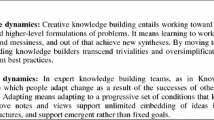Abstract
Although many instructional technologists have suggested that teachers should be trained in using instructional design models, few studies have been conducted to determine if teachers can be successful in acquiring and applying these models. The purpose of this study was to examine preservice teacher success in acquiring and applying principles of learning and instructional design. Preservice teachers enrolled in a professional teacher preparation program were taught the essentials of learning and competency-based instruction and were required to plan a lesson using these concepts. Results indicate that most of the preservice teachers were successful in acquiring and using the principles of learning and instructional design.
Similar content being viewed by others
References
Blumenfeld, P., Young, D., & Pokay, P. (1991, April).Using educational psychology as a vehicle for teaching instructional planning: Promises and problems. Paper presented at the annual meeting of the American Educational Research Association, Chicago.
Branson, R. K. (1987). Why the schools can't improve: The upper limit hypothesis.Journal of Instructional Development, 10(4), 15–26.
Cain, B. N. (1989). With world making, planning models matter.English Education, 21, 5–29.
Clark, C. M., & Yinger, R. J. (1979). Research on teacher planning: A progress report.Journal of Curriculum Studies, 11(2), 175–177.
Dick, W., & Reiser, R. A. (1989).Planning effective instruction. Englewood Cliffs, NJ: Prentice Hall.
Gagné, R. M., & Driscoll, M. P. (1988).Essentials of learning for instruction (2nd ed). Englewood Cliffs, NJ: Prentice Hall.
Higgins, N., Reiser, R. A., & Bebeau, M. (1976, March).Teaching teachers to develop competency-based instructional programs. Paper presented at the meeting of the Association for Educational Communications and Technology, Anaheim, CA.
Higgins, N., & Sullivan, H. (1982). Preparing special education teachers for objectives-based instruction.Teacher Education and Special Education, 5(4), 51–55.
Kerr, S. T. (1981). How teachers design their materials: Implications for instructional design.Instructional Science, 10, 363–378.
Kerr, S. T. (1989). Technology, teachers, and the search for school reform.Educational Technology Research and Development, 37(4), 5–17.
Macdonald, J. B. (1965). Myths about instruction.Educational Leadership, 22(8), 609–617.
Martin, B. L. (1990). Talk about teaching: Instructional systems design within teacher education.Educational Technolgy, 30(7), 32–33, 56.
Neale, D. C., Pace, A. J., & Case, A. B. (1983, April).The influence of training, experience, and organizational environment on teachers' use of the systematic planning model. Paper presented at the annual meeting of the American Educational Research Association, Montreal.
Reiser, R. A. (1986). Some questions facing academic programs in instructional technology and some means for answering them.Journal of Instructional Development, 8(3), 20–23.
Reiser, R. A., & Higgins, N. C. (1975, April).Competency based instruction. Paper presented at the meeting of the Association for Educational Communications and Technology, Dallas, TX.
Rosales-Dordelly, C., & Short, E. (1985).Curriculum professors' specialized knowledge. State College, PA: Nittany Press.
Schiffman, S. S., & Gansneder, B. M. (1987). Graduate programs in instructional technology: Their characteristics and involvement in public education.Journal of Instructional Development, 10(3), 22–28.
Shrock, S. A., & Byrd, D. M. (1987). An instructional development look at staff development in the public schools.Journal of Instructional Development, 10(4), 45–53.
Snelbecker, G. E. (1987). Instructional design skills for classroom teachers.Journal of Instructional Development, 10(4), 33–40.
Sullivan, H., & Higgins, N. (1983).Teaching for competence. New York: Teachers College Press.
Taylor, P. (1970).How teachers plan their courses. London: National Foundation for Educational Research.
Tyler, R. W. (1949).Basic principles of curriculum and instruction. Chicago: University of Chicago Press.
Yinger, R. J. (1980). A study of teacher planning.Elementary School Journal, 80, 107–127.
Zahorik, J. A. (1975). Teachers' planning models.Educational Leadership, 33(3), 134–139.
Author information
Authors and Affiliations
Additional information
The course described in this paper is modeled in part after a course designed by faculty at Florida State University. The author wishes to thank Marcy Driscoll for sharing these course materials. The author also wishes to recognize John Erchul, Ann Igoe, Jayne Klein, and Doris Pridemore for their comments on an earlier draft of this manuscript.
Rights and permissions
About this article
Cite this article
Klein, J.D. Preservice teacher use of learning and instructional design principles. ETR&D 39, 83–89 (1991). https://doi.org/10.1007/BF02296441
Issue Date:
DOI: https://doi.org/10.1007/BF02296441




